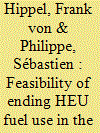|
|
|
Sort Order |
|
|
|
Items / Page
|
|
|
|
|
|
|
| Srl | Item |
| 1 |
ID:
170230


|
|
|
|
|
| Summary/Abstract |
The verification of arms-control and disarmament agreements requires states to provide declarations, including information on sensitive military sites and assets. There are important cases, however, in which negotiations of these agreements are impeded because states are reluctant to provide any such data, because of concerns about prematurely handing over militarily significant information. To address this challenge, we present a cryptographic escrow that allows a state to make a complete declaration of sites and assets at the outset and commit to its content, but only reveal the sensitive information therein sequentially. Combined with an inspection regime, our escrow allows for step-by-step verification of the correctness and completeness of the initial declaration so that the information release and inspections keep pace with parallel diplomatic and political processes. We apply this approach to the possible denuclearization of North Korea. Such approach can be applied, however, to any agreement requiring the sharing of sensitive information.
|
|
|
|
|
|
|
|
|
|
|
|
|
|
|
|
| 2 |
ID:
150308


|
|
|
|
|
| Summary/Abstract |
Since September 11, 2001, the U.S. government has sought to remove weapons-useable highly enriched uranium (HEU) containing 20 percent or more uranium-235 from as many locations as possible because of concerns about the possibility of nuclear terrorism.
|
|
|
|
|
|
|
|
|
|
|
|
|
|
|
|
| 3 |
ID:
135309


|
|
|
|
|
| Summary/Abstract |
Gaseous diffusion was historically the most widely used technology for military production of highly enriched uranium. Since June 2013, all gaseous diffusion enrichment plants worldwide are permanently shut down. The experience with decommissioning some of these plants has shown that they contain large amounts of uranium particles deposited in the cascade equipment. This article evaluates the potential of using uranium particle deposition to understand and reconstruct the operating histories of gaseous diffusion enrichment plants. First, a squared-off cascade enrichment model is derived to estimate the enrichment capacity of a reference plant. Then, using a cross-flow filtration model, the mass of solid uranium particles deposited over time in the tubular separation membranes of the stage diffusers is calculated. Finally, potential techniques to characterize these uranium deposits and help reconstruct the operating history of the plant are assessed.
|
|
|
|
|
|
|
|
|
|
|
|
|
|
|
|
| 4 |
ID:
190278


|
|
|
|
|
| Summary/Abstract |
Between 1966 and 1974, France conducted 41 atmospheric nuclear weapon tests in French Polynesia, exposing local populations to radioactive fallout. Under French law, individuals who were present at the time and later developed certain radiogenic cancers are eligible for compensation from the government—unless it is proven that they could not have received effective doses greater than 1 mSv in any given year. Using new information available from recently declassified documents, as well as atmospheric transport modeling of radioactive fallout, this article shows that upper-bound government estimates of effective doses received by the public have been underestimated by factors of 2 to 10. As a result, approximately 110,000 people, representing 90% of the French Polynesian population at the time, could have received doses greater than 1 mSv per year. Integrating updated dose estimates into the claim adjudication process would enlarge the pool of eligible claimants by a factor of 10.
|
|
|
|
|
|
|
|
|
|
|
|
|
|
|
|
|
|
|
|
|